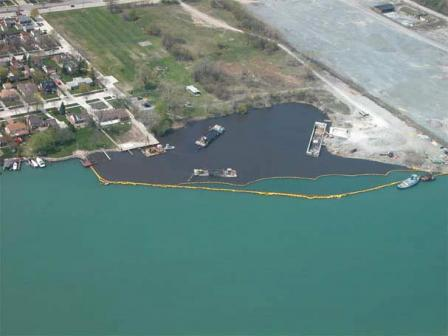
It’s convenient to think of fixing a problem and it’s done. But that doesn’t apply to the long-neglected legacy polluted sites in the Great Lakes region.
In simple terms we think of a cleanup as removal of something that, left unattended, will become a nuisance or a problem. But cleanup of toxic sites, especially in water, is not that simple.
A cleanup generally refers to dredging the site until the toxins are removed or have been removed to an acceptable level. That was the case in 2005 in an area of the Detroit River known as the Black Lagoon, so named for the color of the water polluted with 103,000 cubic yards of contaminated sediment.
That small project by today’s standards is a landmark as it was funded by the newly passed Great Lakes Legacy Act, setting the table for much broader restoration of the Great Lakes.

Detroit River’s Black Lagoon (Photo courtesy of U.S. EPA)
“The Great Lakes Legacy Act showed the region that a significant funding and reinvestment program was possible to write and pass,” Cameron Davis told Great Lakes Now in an email reflecting on the early days of restoration.
Davis and other Great Lakes NGO executives at the time pushed Congress hard for the legacy act and used its passage and initial success to broaden the message that a full blown restoration program as it exists today could succeed.
But not all cleanup projects are as straightforward as remediation of the Black Lagoon.
That’s where putting a cap over a site to contain toxic sediment has become an accepted alternative to dredging and removal of the sediment.
The U.S. EPA sees capping as a permanent solution.
“Capping is typically envisioned as a long-term, permanent remedy,” EPA Great Lakes region spokesperson Allison Lippert told Great Lakes Now.
Lippert cited successful capping under the agency’s Superfund program that goes back more than 20 years.
“Although the history of the Great Lakes Legacy Act projects doesn’t date back as far as the Superfund’s experience, the capping remedies that EPA and our partners have implemented under the GLLA are envisioned as permanent remedies,” Lippert said.
Once a site is capped, in most cases the non-federal partner on the project is responsible for the ongoing maintenance and monitoring of the site and related costs, according to Lippert.
Detroit River Cleanup
The Detroit River’s history is rich, dating back to the 17th century when it was traversed by newly arrived European colonists who traded furs with the Native American Iroquois tribes.
In modern times it became a transportation and industrial hub as Detroit and the Great Lakes region grew into a manufacturing powerhouse for auto and steel production.
But with industrial prominence came unfettered pollution as economies boomed and the river was used as a convenient dumping ground for toxic production waste, much of which remains submerged in the river today.
By 1987, the Detroit River was included on a U.S. and Canada list of 43 toxic sites – 26 in the U.S. and 12 in Canada plus 5 joint sites – that were targeted for cleanup. The sites are known as Areas of Concern or AOCs.
Fast forward to 2020, and seven sites have been remediated and removed from the original list. Ongoing work is making varying levels of progress at other sites, including the Detroit River.
EPA is currently working with the Detroit Riverwalk Conservancy to cap a site upstream from downtown Detroit.
But best estimates of a cleanup for the river are 2025 or beyond, according to the U.S. EPA who oversees the work.
There are eleven U.S. sites in the Great Lakes region that have undergone dredging and capping, according to the EPA’s Great Lakes office.
Read more Great Lakes Now stories on Detroit here.
Pros and cons of capping
Sam Noffke, an aquatic biologist, does work on contaminated sites for Michigan’s Department of Environment Great Lakes, and Energy. Great Lakes Now asked him to comment on the pros and cons of capping sites.
Capping is most commonly used to contain contaminated sediment because it provides for a “quick risk reduction” and “it’s fairly easy to implement,” Noffke said.
He said it can be seen as cost effective compared to dredging and it means that storage of dredged material is not necessary, avoiding another expense.
On the negative side of capping Noffke cited the fact that even though encapsulated, the toxic sediment remains in the aquatic environment and monitoring and maintenance of the cap can be required in perpetuity.
“The cap could be subject to potential storms, accidental collisions creating damage to the cap, potentially exposing the material below the cap,” Noffke said.
EGLE has never done capping because of the monitoring and maintenance in perpetuity requirement, according to spokesperson Nick Assendelft.
Fourteen of the original AOCs on the 1987 list are in Michigan and eleven remain.
Grand Valley State University’s Richard Rediske told Great Lakes Now that it’s not always feasible to sufficiently dredge a contaminated site “so a compromise is made to remove highly contaminated sediments and then restore the lake or river bottom to the original grade by capping with sand or installing a barrier with sand on top.”
Rediske, a professor with the Annis Water Resources Institute, said thoughts on capping as the sole remedy to remediate a site are still evolving.
He also cited the long-term monitoring costs related to capping and the potential of future liabilities as issues to consider before capping a site.
No set formula
There is no set formula to determine if a site should be dredged, capped or a combination of the two, according to Raj Bejankiwar, a physical scientist in the International Joint Commission’s Great Lakes office in Windsor, Ontario.

Raj Bejankiwar, International Joint Commission Great Lakes Office physical scientist (Photo courtesy of the International Joint Commission)
Bejankiwar said there’s a “systematic process” that considers a site’s hazard level, the feasibility of removing sediment and cost among the factors before determining a remedial course of action.
He is less concerned about capping sites in the Detroit River as they are near shore and out of the rapid flow area, but said any cap would require oversight, maintenance and monitoring for 25 to 30 years.
“Most of the work on Great Lakes AOC’s has been done in the last 10 years so we are learning as we go,” Bejankiwar said.
The current federal work on the Areas of Concern is not the first effort to clean up the sites.
In 1987 Michigan Gov. Jim Blanchard launched a Great Lakes 2001 program designed to clean up the toxic sites in Michigan by 2001, according to Dave Dempsey, then a Blanchard adviser.
But Dempsey, now a senior adviser to For Love of Water, said funding for the project ended when Blanchard, a Democrat, lost his reelection bid to Republican John Engler.
Read more on Great Lakes cleanups on Great Lakes Now:
Great Lakes Moment: Cleanup of contaminated river sediment begins at old Uniroyal site
Roller Coaster: Michigan’s long history with environmental contamination
Backlog of toxic Superfund clean-ups grows under Trump
River Restoration: $390 million project offers new future for beleaguered Kinnickinnic
API key not valid. Please pass a valid API key.Featured image: A silt screen curtain was placed in the Detroit River off the former Uniroyal site to contain sediments resuspended during sediment remediation. (Photo credit: Detroit Riverfront Conservancy)




